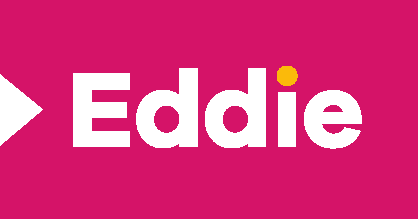Working with a professional production team on video creation combines your team’s expertise and authentic footage with professional editing skills for optimal results. In this collaborative approach, your employees record content while experienced editors transform raw material into polished videos. This partnership eliminates the need for expensive camera crews, enables faster turnaround times, and preserves authenticity while ensuring professional quality. At Eddie, we’ve perfected this process to make video production accessible, efficient, and effective.
What does co-creating a video with a production team mean?
Video co-creation is a collaborative approach where internal team members capture footage while professional editors handle post-production. Rather than hiring expensive filming crews or struggling with DIY editing tools, this partnership leverages each party’s strengths. Your employees bring authentic storytelling and subject matter expertise, while editors contribute technical skills and creative finesse.
At Eddie, we pioneered this approach in Europe in 2015, recognizing how businesses could benefit from this balanced methodology. The co-creation model offers several advantages: significantly lower costs, faster turnaround times, authentic content featuring your actual team members, and consistently professional results through expert editing.
This approach is particularly valuable for organizations producing regular video content—whether for internal communications, marketing, training materials, or social media—where maintaining quality while scaling production is essential.
How do I prepare my team for recording video content?
Equipping your team with basic filming knowledge ensures they capture footage that editors can transform into professional videos. Start by providing clear guidelines about shot composition, focusing on stable, well-lit environments with minimal background noise.
For equipment, smartphones with good cameras can work effectively when paired with external microphones for better audio quality. Eddie’s Gadget Pack turns smartphones into professional recording setups with all necessary accessories in one convenient case.
Basic filming techniques to teach your team include:
- Recording in landscape orientation (horizontal)
- Using natural light when possible, facing subjects toward light sources
- Keeping shots steady with tripods or stabilizers
- Capturing extra footage (b-roll) to supplement main content
- Recording in quiet environments to ensure clear audio
Consider arranging a training session like Eddie’s Kickstart Course, which teaches employees video fundamentals in just one day, covering both filming techniques and script development.
What information should I provide to the video editor before recording?
Sharing essential project details with your editing team before filming begins helps align expectations and ensures the final product meets your goals. Start by clearly outlining your video’s purpose and target audience, as these fundamentals shape every aspect of production.
Your pre-production communication should include:
- Project goals – What specific outcomes should this video achieve?
- Target audience characteristics and preferences
- Key messages and talking points to emphasize
- Branding requirements (logos, colors, fonts, style guidelines)
- Timeline expectations and delivery deadlines
- Technical specifications (length, resolution, format requirements)
Additionally, share examples of videos you admire or previous content that represents your desired style. This visual reference helps editors better understand your aesthetic preferences and expectations.
How should employees capture and submit raw footage?
Organized footage submission streamlines the editing process and prevents delays or miscommunications. Establish clear file naming conventions before recording begins, using descriptive names that identify content, date, and sequence (e.g., “Interview_CEO_ProjectLaunch_Jan15_Take2”).
For file formats, most editors prefer MP4 or MOV files recorded at 1080p resolution. Larger 4K files can be useful for specific purposes but require more storage and processing power.
Create a logical folder structure for organizing content:
- Main interviews
- B-roll (supplementary footage)
- Graphics or existing assets
- Reference materials
When transferring files, use secure cloud-based platforms like Eddie’s Cobie system, which allows direct uploads from phones and facilitates collaboration between team members. Avoid compressing files or using email attachments, as these methods can degrade video quality.
What happens during the video editing and production phase?
Once your footage reaches the editing team, a structured workflow transforms raw material into a polished final product. Initially, editors review all submitted content to assess quality and identify the strongest elements to feature.
The typical editing process includes:
- Content organization and selection of best takes
- Assembly of a rough cut that establishes narrative structure
- Addition of supporting elements (graphics, music, text)
- Technical refinements (color correction, audio balancing)
- Application of branded elements and transitions
At Eddie, our timeline wizards specialize in transforming amateur footage into professional business videos. They’re experts in everything from sound engineering to color grading and animation. Throughout this phase, regular communication ensures the project stays aligned with your vision while benefiting from professional expertise.
How can we ensure efficient feedback during the revision process?
Clear, organized feedback makes revision rounds productive and prevents miscommunication. When reviewing drafts, use frame-specific comments that pinpoint exactly where changes are needed rather than general observations.
For effective feedback:
- Consolidate input from all stakeholders before submitting
- Prioritize changes by importance
- Be specific about what needs modification
- Provide examples or references when possible
Establish a limited number of revision rounds (typically 2-3) to maintain project momentum and prevent endless tweaking. Tools like Eddie’s Cobie platform facilitate this process by allowing direct comments on specific video moments and maintaining clear version control.
Video Co-Creation Best Practices and Future Opportunities
Successful video co-creation relies on clear communication, defined roles, and mutual respect for each party’s expertise. As your organization becomes more comfortable with this approach, you’ll find opportunities to scale production across departments while maintaining consistent quality.
To maximize the value of your co-creation partnership:
- Invest in basic filming training for key team members
- Create standardized templates for recurring video types
- Develop a content calendar to plan productions strategically
- Build a library of approved b-roll footage for future use
As your team’s skills advance, you can explore more sophisticated projects, leveraging professional editing expertise for increasingly complex productions while keeping costs manageable through the co-creation model. If you’re interested in learning more, contact our team today.

